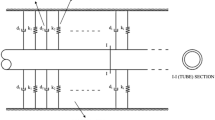Abstract
Assuming that the free energy depends on the deformation gradient and the spatial electric field, we derive the expressions for the Cauchy stress tensor and the spatial electric displacement from an observer invariant quadratic form of the free energy via the strict definitions of these quantities. Specific forms of the Piola-Kirchhoff stress tensor and the material electric displacement are then deduced and linearized in a particular sense. As an application of the resulting theory, we formulate the problem of an electrically driven disc within the context of the classical bending theory of thin plates. The material of the disc is assumed to have at most the symmetry of a hexagonal system of classC 6v.The resulting coupled differential equations for the axial mechanical displacement of the middle surface and the material electric potential indicate that the problem is not empty. This result is of particular interest in view of the fact that it is generally held that the classical theory of piezoelectricity does not permit such couplings to occur.
Similar content being viewed by others
References
P.J. Chen, Observation of the existence of electrically excited purely mechanical resonance in piezoelectric and ferroelectric materials.Il Nuovo Cimento 2D (1983) 1145–1155.
P.J. Chen, Electrically excitable purely mechanical resonances in piezoelectric and ferroelectric materials-geometrical considerations.Wave Motion 5 (1983) 177–183.
P.J. Chen, Electrically excitable mechanical resonant mode shapes in the electro-optic ceramic PLZT7/65/35.Int. J. Solids Struct. 22 (1986) 909–917.
P.J. Chen, Electrically driven flexural resonant modes in symmetrically electroded X-cut and Z-cut quartz discs.IEEE Transactions on Ultrasonics, Ferroelectrics and Frequency Control 35 (1988) 66–72.
P.J. Chen, Electrically and mechanically induced body macroscopic body couple — a newly recognized phenomenon of electromechanical interaction.Il Nuovo Cimento 8D (1986) 481–496.
V.V. Novozhilov,Foundations of the Non-linear Theory of Elasticity. Rochester: Graylock Press (1953).
R. Holland and E.P. EerNisse,Design of Resonant Piezoelectric Devices. Cambridge: MIT Press (1969).
R.C. Cowell and H.C. Hardy, The frequencies and nodal systems of circular plates.Phil. Mag. S7, 24 (1937) 1041–1055.
R.D. Blevins,Formulas for Natural Frequency and Mode Shape. New York: van Nostrand Reinhold (1979).
Author information
Authors and Affiliations
Rights and permissions
About this article
Cite this article
Chen, P.J. A linearized theory of elastic dielectrics which couples electrically to flexural vibrations. J Elasticity 21, 83–99 (1989). https://doi.org/10.1007/BF00040935
Received:
Accepted:
Issue Date:
DOI: https://doi.org/10.1007/BF00040935




